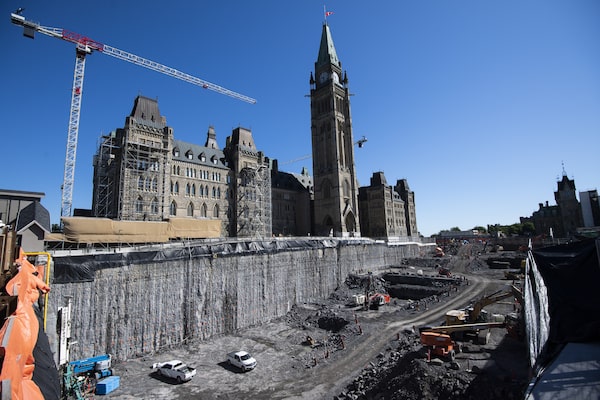
The ground in front of Parliament Hill's Centre Block is excavated for the building of the new welcome centre, seen during a media tour of Centre Block renovations on Parliament Hill in Ottawa, on June 16, 2021.Justin Tang/The Canadian Press
In Canada today, public architecture is a lot like a highway: Nobody really asks for it to express Canadian culture, or for it to be culture at all.
Yet public buildings – above all the Houses of Parliament – are central to our national self-image. And right now, with a pair of projects key to the reconstruction of Parliament Hill, Public Services and Procurement Canada is sending mixed messages about how we value architecture.
One is the gut renovation of Centre Block, the Gothic Revival heart of the federal government. Its revamp will cost at least $4.5-billion and take until 2032. Few details of the design, led by the multinational architecture firm HOK, have been released.
And since this spring, architects have been exploring ideas for Block 2. It will remake nine buildings, located on Wellington Street across from Parliament Hill, as office and back-of-house space. This will be a complex juggling of wish lists, heritage preservation and technical requirements. This fall, 12 selected teams of designers will submit concepts, one of which will lead to construction.
The two projects are part of a multiphased rebuild of Parliament Hill. In 2019, the government unveiled the temporary homes of Parliament: new chambers for the House and Senate, created by an army of consultants. Public architecture should reflect a society’s political ideals and aesthetic aspirations; these spaces are all brass and walnut, like a luxury house built for an especially boring banker.
Block 2 could be different. The competition teams include a mix of international and Canadian architects. Among the top names are David Chipperfield, Foster & Partners, Bjarke Ingels Group and Canada’s KPMB.
This is a good selection of the world’s best architects. The foreigners are linked up with Canadians (each team must have at least one domestic partner), including the young Toronto firm Partisans – which, under normal circumstances, would never be considered for a big public project.
Why this approach? “Block 2 has a very public face,” says Bruce Haden, a prominent Vancouver architect who is the chair of the competition’s jury. “It is the building that, when you are in the Centre Block, you will look out on.” It also involves significant new construction.
It’s exciting to see the federal government running a competition: It’s a good method to achieve quality design. Typically in Canada, governments hire architects through Byzantine procurement procedures. This gives the advantage to big firms with efficient support staff. Unfortunately, they generally lack the qualities that create great architecture: creative ambition and a relentless commitment to seeing ideas through.
This punishing dynamic appears to be playing out at Centre Block. In 2017 a team called CENTRUS, which involves HOK and engineering firm WSP, won a joint 10-year, $230-million contract. The project involves a gut job on the century-old building; the addition of new space (filling in the courtyards within the building); and the second phase of the Visitor Welcome Centre, a massive underground facility that will be Parliament’s public front door.
HOK is a large American-based firm best known for designing airports. They surely have the size and competence to wrangle this beast of a building project. But can they turn it into art?
The architecture deserves to be spectacular. The welcome centre, especially, is a major public building. The work within Centre Block will include new glass roofs on the courtyards and a variety of small interventions – but how will these contemporary elements speak to the ornate early-20th-century Gothic of the existing buildings? This requires a subtle touch, such as the one Chipperfield applied to Berlin’s Neues Museum.
The person in charge of the Parliament Hill reconstruction is Rob Wright, Assistant Deputy Minister for Science and Parliamentary Infrastructure. I asked him: Why a design competition for Block 2 but not Centre Block – which is arguably more important?
The Centre Block “is, first and foremost, a restoration and the preservation of the heritage landscape of Parliament Hill,” Mr. Wright replied. The designers “had to get the heritage restoration right as a foundation.” The government has hired the Royal Architectural Institute of Canada and a team of prominent outside observers to provide independent design review.
“They are different processes,” Mr. Wright explained, “but they each get us to the result of design excellence for these very important projects.”
I doubt this. Procurement is destiny. The method through which the government hired the Centre Block designers is likely to produce architecture that’s technically competent but uninspired and uninteresting.
By contrast, Block 2, which most Canadians will never visit, suggests an ambition to see design as an art form and a problem-solving tool. “As a country, we have punched under our weight, in design terms,” Mr. Haden says. “We need to find more opportunities to represent Canadian democracy visually and spiritually.”
He’s right. And to do that will require boldness and creativity, not design by committee.
Our Morning Update and Evening Update newsletters are written by Globe editors, giving you a concise summary of the day’s most important headlines. Sign up today.